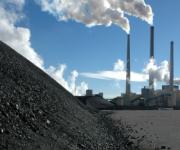I’m involved in an ongoing email debate over the wisdom of “clean coal” — that is, coal power plants that capture and sequester their carbon dioxide emissions. It will eventually be published on a State Dept. website, and then in Grist. In the meantime, a preview of sorts.
A frequent argument one hears in favor of a heavy focus on carbon sequestration goes like this: fossil fuels are fantastic energy carriers, dense, portable, and cheap. People will burn them up no matter what. So we might as well figure out a way to make them low-carbon by sequestering their emissions. It’s a way to buy time as we figure out other clean energy options.
It’s a seductive argument. It sounds easier to convince people to clean up what they’re already doing than to persuade them to do something entirely different.
But I don’t think it holds up under scrutiny. It trades on the implicit notion that sequestering CO2 is just a matter of tweaking our current power system a bit — a quick, low-cost twist on business-as-usual. That would be easier than shutting dirty power plants down and building a new infrastructure based on renewables, efficiency, and intelligent grids.
It’s wrong, though:
1. Sequestration is not a low-cost alternative. CCS is expensive! Nobody has any idea how much it will cost once it has been scaled up to the point that it’s capturing the bulk of CO2 emissions from the bulk of the world’s coal power plants. Most current estimates, though, are that it adds about 30-40% on to the cost of building a new plant and up to 50-60% to the cost of running existing pulverized coal plants. That is not a low-cost alternative to higher-cost renewables. It’s one higher-cost option among others.
2. Sequestration is not modification of existing infrastructure. It’s new infrastructure, and a lot of it. As Vaclav Smil pointed out in a widely cited 2006 paper in Nature (PDF), capturing and sequestering just 10% of global CO2 emissions would require the creation of an infrastructure that would handle as much as or more volume than that extracted by the global oil industry (which has been built up over a century). Sequestering the 40% of global emissions for which coal plants are responsible would mean infrastructure four times as extensive as the entire global oil industry’s. That’s not some tweak on what we’ve got; it’s a mind-bogglingly enormous new industrial project that wouldn’t be up and commercialized until, on the most optimistic projections, 2025-2030.
So the Argument from Fossil Fuels (as I will now take to calling it) needs to be clarified. If the point is that the countries of the world are going to keep burning fossil fuels because they want the cheapest possible power no matter what, then we’re doomed. Period. No country that prioritizes the cheapest energy in the short-term is going to opt for CCS — it’s not cheap, or short-term.
If, on the other hand, the argument is that countries will opt for the low-carbon energy path that represents the easiest, cheapest, and fastest alternative to dirty fossil fuels, well, then, now we’re really having a discussion. Now the argument for CCS has to show that it’s easier, cheaper, and faster than efficiency and renewables. I don’t think it can win that argument.




